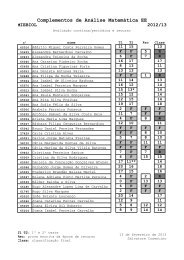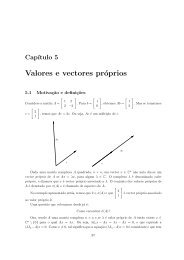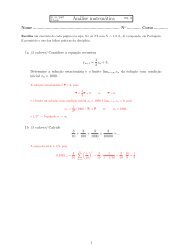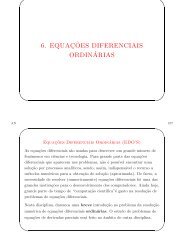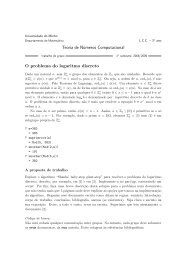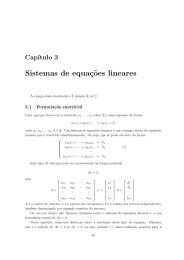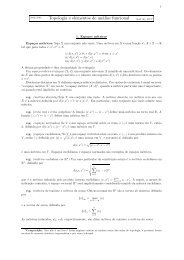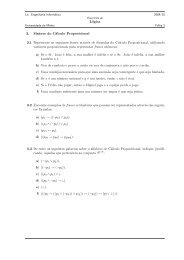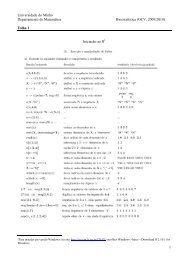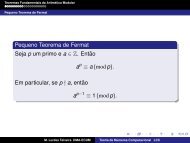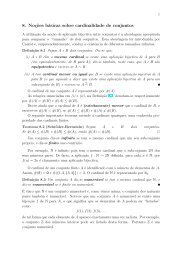My title - Departamento de Matemática da Universidade do Minho
My title - Departamento de Matemática da Universidade do Minho
My title - Departamento de Matemática da Universidade do Minho
You also want an ePaper? Increase the reach of your titles
YUMPU automatically turns print PDFs into web optimized ePapers that Google loves.
16 ERGODICITY AND CONVERGENCE OF TIME MEANS 104<br />
Now, let ϕ k be the the characteristic function of {x ∈ Σ + s.t. x 1 = k}. The observables ϕ k ◦σ n<br />
form a sequence of in<strong>de</strong>pen<strong>de</strong>nt and i<strong>de</strong>ntically distributed ran<strong>do</strong>m variables with mean p k . One<br />
can interprete the event {ϕ k ◦ σ n = 1} = {x ∈ Σ + s.t. x n = k} as ”sucess in the n-th trial”, where<br />
the probability of sucess in each trial is p k . The Birkhoff-Khinchin ergodic theorem, together with<br />
the ergodicity of µ, gives the result that<br />
µ<br />
{<br />
x ∈ Σ + s.t.<br />
1 (<br />
ϕk + ϕ k ◦ σ 1 + ϕ k ◦ σ 2 + ... + ϕ k ◦ σ n) }<br />
(x) → p k = 1<br />
n + 1<br />
which is the Kolmogorov strong law of large numbers.<br />
Expanding en<strong>do</strong>morphisms of the circle. Let ×λ : x+Z ↦→ λ·x+Z, with λ ∈ Z and |λ| > 1,<br />
be an expanding en<strong>do</strong>morphism of the circle. Lebesgue probability measure l is an ergodic measure<br />
for ×λ. To prove ergodicity, let A be an invariant Borel set, and assume that l (A) < 1. We<br />
must show that the complement B = (R/Z) \A, that has positive measure, has in<strong>de</strong>ed probability<br />
one. The argument goes as follows: if l (B) > 0, then, according to Lebesgue <strong>de</strong>nsity theorem, B<br />
contains nearly all the mass of some nonempty interval. Namely, given any ε > 0, we can find an<br />
open interval I n with lenght l (I n ) = |λ| −n and centered at a <strong>de</strong>nsity point of B such that<br />
l (B ∩ I n ) > (1 − ε) · l (I n )<br />
Now observe that the restriction (×λ) n | In is an injective map sending I n onto the circle minus<br />
one point, in particular, l ((×λ) n (I n )) = 1. Since ×λ uniformly dilatates lenghts by a factor |λ|,<br />
there follows that<br />
l ((×λ) n (B ∩ I n ))<br />
l ((×λ) n (I n ))<br />
= l (B ∩ I n)<br />
l (I n )<br />
Since, moreover, A is invariant, its complement B is +invariant, and this implies that the left-hand<br />
si<strong>de</strong> above is equal to l (B). There follows that<br />
and, since ε was arbitrary, that l (B) = 1.<br />
16.3 Normal numbers<br />
l (B) = l (B ∩ I n)<br />
l (I n )<br />
> (1 − ε)<br />
Normal numbers. In particular, Lebesgue measure l is ergodic w.r.t. multiplication by 10<br />
in the unit circle. I<strong>de</strong>ntify the circle with the interval [0, 1[, and let x = 0, x 1 x 2 x 3 ... be the base<br />
10 expression of a point of the circle, which is unique outsi<strong>de</strong> a subset of Lebesgue measure zero.<br />
For k = 0, 1, 2, ..., 9, let ϕ k be the characteristic function of the interval [k/10, (k + 1) /10[, i.e. the<br />
observable which is equal to ϕ k (x) = 1 if x 1 = k and ϕ k (x) = 0 otherwise. The time mean of ϕ k<br />
is<br />
1<br />
n + 1<br />
n∑<br />
j=0<br />
)<br />
ϕ k<br />
((×10) j (x) = 1<br />
n + 1 · card {1 ≤ j ≤ n + 1 s.t. x j = k}<br />
that is the number of k’s within the first n + 1 digits of the <strong>de</strong>cimal expansion of x. The limit as<br />
n → ∞, if it exists, is the “asymptotic frequency” of k’s contained in the expansion of x. Ergodicity<br />
of µ implies that there exists a set A k ⊂ [0, 1[ of Lebesgue measure one where the limit ϕ k (x)<br />
exists and is equal to ∫ ϕ k dl = 1/10. Since the intersection A 0 ∩ A 1 ∩ ... ∩ A 9 has still probability<br />
one, the result is that Lebesgue almost any number x ∈ [0, 1[ contains in its <strong>de</strong>cimal expansion any<br />
of the letters 0, 1, 2, ..., 9 with asymptotic frequency 1/10.<br />
Actually, one could repeat the same argument consi<strong>de</strong>ring any finite word b = b 1 b 2 ...b n in the<br />
alphabeth {0, 1, 2, ..., 9}, and show that there is a set A b ⊂ [0, 1[ of probability one such that the<br />
base 10 expansion of any x ∈ A b contains the word b with asymptotic frequency 10 −n . A real<br />
number x whose base 10 expansion contains any finite word with the right asymptotic frequency is<br />
called 10-normal (meaning “normal in base 10”). Since finite words in the alphabeth {0, 1, 2, ..., 9}<br />
are countable, and a countable union of zero measure sets still has zero measure, we just showed<br />
that Lebesgue almost any real number x is 10-normal. This observation, and in<strong>de</strong>ed the stronger



